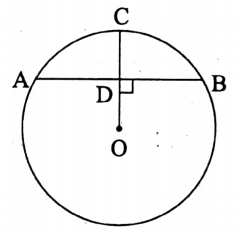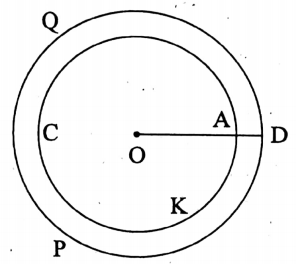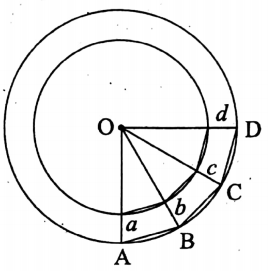Mensuration Chapter 2 Circumference Of Circles
Chapter 2 Circumference Of Circles Chord of a circle
1. Chord of a circle:
The line segment joining the two end points of an arc is called the chord of the arc.
O is the center of the circle.
C is the mid-point of the arc ACB and the straight line AB is the chord of the arc ACB.
CD ⊥ AB and CD are called the height of the arc ACB.
Read and Learn More WBBSE Solutions For Class 9 Maths

2. Ring:
The circles having the same center are called concentric.
The region closed by two circumferences of two concentric circles is called a ring.
In, the region closed by the circumference PDQ and ACK is a ring.
Here, PDQ is the outer circumference and ACK is the inner circumference.

Chapter 2 Circumference Of Circles Circumference Of A Circle
Circumference Of A Circle:-
The circumference of a circle is usually known as its perimeter.
The measurement of the circumference of a circle is always \(\frac{22}{7}\) times its diameter.
Thus, the ratio between the circumference and the diameter of a circle is always constant.
Proof: Let us draw two circles with co-center O and radius R and r (R > r).
In the first circle, a regular polygon ABCD……….. is constructed, the number of sides of which is, say, n.
Now, if OA, OB, OC, OD……etc. are joined, they intersect the second circle at a, b, c, and d.
etc., n-points.
If ab, bc, cd,……… are joined, then a regular polygon abcd………etc., is constructed in the second circle.
Now, in ΔOAB and ΔOab, \(\frac{\mathrm{OA}}{\mathrm{O} a}=\frac{\mathrm{OB}}{\mathrm{O} b}\) [∵ OA = OB and Oa = Ob ]
Again, since ZAOB = ZaOb,
∴ the triangles ΔOAB = ΔOab are similar.
∴ \(\frac{\mathrm{AB}}{a b}=\frac{\mathrm{OA}}{\mathrm{O} a}=\frac{\mathrm{R}}{r}\)
Similarly ab bc \(\frac{\mathrm{AB}}{a b}=\frac{\mathrm{BC}}{b c}=\frac{\mathrm{CD}}{c d}=\cdots \cdots=\frac{\mathrm{R}}{r}\)
∴ \(\frac{(\mathrm{AB}+\mathrm{BC}+\mathrm{CD}+\cdots \cdots)}{(a b+b c+c d+\cdots \cdots)}=\frac{\mathrm{R}}{r}\)
i.e., \(\frac{\text { Perimeter of the polygon ABCD } \cdots \cdots}{\text { Perimeter of the polygon } a b c d \cdots \cdots}=\frac{\mathrm{R}}{r}=\frac{\text { Radius of the circle ABCD }}{\text { Radius of the circle } a b c d}\)
Now, if n→ ∞, i.e. if the number of sides n is an infinitely large number, then the perimeter of the polygon gradually coincides with the circumference of the circle.
∴ \(\frac{\text { Circumference of } \mathrm{ABCD}}{\text { Circumference of } a b c d}=\frac{\text { Radius of } \mathrm{ABCD}}{\text { Radius of } a b c d}=\frac{\mathrm{R}}{r}=\frac{2 \mathrm{R}}{2 r}=\frac{\text { Diameter of ABCD }}{\text { Diameter of } a b c d}\) = constant
∴ \(\frac{\text { Circumference of ABCD }}{\text { Diameter of } \mathrm{ABCD}}=\frac{\text { Circumference of } a b c d}{\text { Radius of } a b c d}=\text { constant }\)
This constant is usually denoted by π.
∴ Circumference of a circle = π × Diameter.
∵ Circumference of a circle = π x 2r (r = radius)
= 2πr

Chapter 2 Circumference Of Circles Select The Correct Answer (MCQ)
Question 1. Soma takes time \(\frac{πx}{100}\) minutes to round a circular park. Then Soma will take time to cross the park along its diameter-
- \(\frac{x}{200}\) minutes
- \(\frac{x}{100}\) minutes
- \(\frac{π}{100}\)minutes
- \(\frac{π}{200}\) minutes
Solution:
Let the radius of the park be units.
∴ diameter = 2 units and circumference = 2лr units.
Now, to round 2πr units time required by Soma is \(\frac{πx}{100}\) minutes
∴ to round 1 units time required by Soma is \(\left(\frac{\pi x}{100} \div 2 \pi r\right)\) minutes
∴ to round 2r units time required by Soma is \(\left(\frac{\pi x}{100} \times \frac{1}{2 \pi r} \times 2 r\right) \text { minutes }=\frac{x}{100} \text { minutes }\)
Question 2. A circle is inscribed in a square. If the side of the square is 10 cm, then the diameter of the circle is
- 10 cm
- 5 cm
- 20 cm
- 10√2 cm
Solution:
Since the circle is inscribed in the square, the side of the square is equal to the diameter of the circle.
∴ the diameter of the circle is 10 cm.
Question 3. A circle is circumscribed about a square. If the side of the square is 5 cm, then the diameter of the circle is
- 5√2 cm
- 10√2 cm
- 5 cm
- 10 cm
Solution:
Since the circle is circumscribed about the square, the diameter of the circle is equal to the diagonal of the square.
Now, the side of the square is 5 cm,
∴ diagonal side x √2 = 5√2 cm.
∴ the diameter of the circle = 5√2 cm.
Question 4. A circular ring is of breadth 5 cm. Then the difference between the ex-radius and in-radius of the ring is
- 5 cm
- 2.5 cm
- 10 cm
- None of these
Solution:
Let the ex-radius of the ring = R cm and-in-radius of the ring = r cm.
The breadth of the ring = (R – r) cm = 5 cm (as per question)
∴ The required difference = 5 cm.
Chapter 2 Circumference Of Circles Short Answer Type Questions
Question 1. Find the ratio of the in-radius and circum-radius of a square.
Solution:
On-Radius And Circum-Radius Of A Square:-
Let the side of the square = a unit.
∴ Diameter of in-circle = a units and in-radius= \(\frac{a}{2}\) units.
∴ Again, the diameter of the circum-circle = diagonal of the square = √2a units
∴ Curcum-radius = \(\frac{\sqrt{2} a}{2} \text { units }=\frac{a}{\sqrt{2}} \text { units }\)
∴ in-radius: circum-radius = \(\frac{a}{2}: \frac{a}{\sqrt{2}}=\frac{a}{2} \times \frac{\sqrt{2}}{a}=\frac{1}{\sqrt{2}}=1: \sqrt{2}\)
Question 2. If the diameter of a circle and the side of a square are equal, then find the ratio of their perimeters.
Solution:
Given
The diameter of a circle and the side of a square are equal
Let the diameter of the circle side of the square=2a units.
∴ The perimeter of the circle = 2πa units and the perimeter of the square = 4 x 2a units = 8a units.
The required ratio = 2πa: 8aπ: 4 = \(\frac{22}{7}\) :4 11:14
Question 3. The minute’s hand of a clock is of length 7 cm. To round an angle of 90°, what length of arc should it travel?
Solution:
Given
The minute’s hand of a clock is of length 7 cm. To round an angle of 90°.
The required length = the length of the arc produced by the angle 90° at the center of a circle of radius 7 cm.
= \(\frac{Angle at the centre}{360º}\) x (circumference of the circle)
= \(\frac{90º}{360º}\) x 2π x 7 cm = \(\frac{1}{4}\) x 2 x \(\frac{22}{7}\) x7 cm = 11 cm
The required length = 11 cm.
Question 4. If the perimeter of a semi-circle is 36 cm, then find its length of diameter.
Solution:
Given
The perimeter of a semi-circle is 36 cm.
Let the radius of the semi-circle = r cm.
∴ The perimeter of it = (πr + 2r) cm.
As per the question, πr+2r=36
⇒ r(π+2) = 36
⇒ \(r\left(\frac{22}{7}+2\right)=36\)
⇒ \(r \times \frac{36}{7}=36 \Rightarrow r=7\)
∴ 2r= 2 x 7 cm = 14 cm. 7
The required diameter = 14 cm.
Chapter 2 Circumference Of Circles Long Answer Type Questions
Question 1. The radius of the wheel of a train is 0.35 m. If the wheel rounds 450 times in one minute, then find the velocity of the train per hour.
Solution:
Given
The radius of the wheel of a train is 0.35 m.
the wheel rounds 450 times in one minute.
Radius of the wheel = 0.35 m,
∴ circumference of the wheel = 2 x \(\frac{22}{7}\) x 0.35 m
= 2.2 m
∴ the train travels in one minute = 2.2 x 450 m
= 990 m
∴ the train travels in one hour = 990 x 60 m
= 59400 m
= 59.4 km
∴ the velocity of the train = 59.4 km per hour.
Question 2. A rectangular wire of length 18 cm and breadth 15 cm is bent into a circular wire. Then find the radius of this circular wire.
Solution:
Given
A rectangular wire of length 18 cm and breadth 15 cm is bent into a circular wire.
The length and breadth of the rectangular wire are 18 cm and 15 cm respectively.
∴ its perimeter = 2 x (18 + 15) cm = 66 cm
Let the radius of the circular wire = r cm
∴ Circumference = 2 πг cm
As per question, = 2 πr = 66
⇒ \(2 \times \frac{22}{7} \times r=66 \quad \Rightarrow r=\frac{21}{2}=10 \cdot 5\)
∴ the required radius = 10.5 cm.
Question 3. Puja and Mohammad started a competition of race at the same time and same point on a circular track of diameter 56 m. When Puja finished the race by rounding 10 times the track, Mohammad then remained one round behind Puja. How many meters was the race and by what meters Puja defeated Mohammad?
Solution:
Given
Puja and Mohammad started a competition of race at the same time and same point on a circular track of diameter 56 m.
When Puja finished the race by rounding 10 times the track, Mohammad then remained one round behind Puja.
The diameter of the circular track = 56 m,
∴ Circumference of the track= \(\frac{22}{7}\) x 56 m
= 176 m
∴ 1 round of the track = 176 m
∴ 10 round of the track = 176 x 10 m = 1760 m
∴ the race was 1760 meters and Puja defeated Mohammad by 176 meters.
Question 4. The time taken by Rahim to travel along the diameter of a circular field is 40 sec less as he takes the time to round the field. If the speed of Rahim is 90 m per minute, then find the diameter of the field.
Solution:
Given
The time taken by Rahim to travel along the diameter of a circular field is 40 sec less as he takes the time to round the field.
The speed of Rahim is 90 m per minute.
Let the radius of the circular field be m.
∴ its circumference 2лrm and diameter = 2r m
The time required to travel along the circumference
= \(\frac{\text { Distance travelled }}{\text { speed }}=\frac{2 \pi r \mathrm{~m}}{90 \mathrm{~m} / \text { minute }}=\frac{2 \pi r}{90} \text { minutes }\)
And the time required to travel along the diameter = \(\frac{2 r \mathrm{~m}}{90 \mathrm{~m} / \mathrm{m}}=\frac{2 r}{90} \text { minutes }\)
As per question, \(\frac{2 \pi r}{90}-\frac{2 r}{90}=\frac{2}{3}\) [ ∵ \(40 \mathrm{sec}=\frac{40}{60} \text { minute }=\frac{2}{3} \text { minute }\) ]
or, \(\frac{2 r}{90}(\pi-1)=\frac{2}{3} \quad \text { or, } \frac{2 r}{90}\left(\frac{22}{7}-1\right)=\frac{2}{3} \quad \text { or, } \quad \frac{2 r}{90} \times \frac{15}{7}=\frac{2}{3}\)
or, \(2 r=\frac{2 \times 90 \times 7}{3 \times 15} \quad \text { or, } 2 r=28\)
∴ the required diameter = 28 m.
Question 5. The ratio of the circumferences of the two circles is 2 : 3 and the difference between their radii is 2 cm. Find the diameters of the circles.
Solution:
Given
The ratio of the circumferences of the two circles is 2 : 3 and the difference between their radii is 2 cm.
Let the radius of the greater circle be \(r_1\) cm and that of the smaller one be \(r_2\) cm.
∴ \(r_1-r_2=2 \ldots(1) \text { and } 2 \pi r_2: 2 \pi r_1=2: 3 \ldots \ldots (2)\)
From (1) we get, \(r_1=r_2+2\) ………………(3)
From (2) we get, \(\frac{2 \pi r_2}{2 \pi r_1}=\frac{2}{3} \Rightarrow 3 r_2=2 r_1 \Rightarrow r_2=\frac{2}{3} r_1\) ………………(4)
From (3) we get, \(r_1=\frac{2}{3} r_1+2 \Rightarrow 3 r_1=2 r_1+6 \Rightarrow r_1=6 \Rightarrow 2 r_1=2 \times 6=12\)
From (4) we get, \(r_2=\frac{2}{3} \times 6=4 \Rightarrow 2 r_2=2 \times 4=8\)
∴ the required diameters are 12 cm and 8 cm.
Question 6. Four greatest circular plates have been cut out from a circular plate of area 196 sq-cm. Find the circumference of each of the plates.
Solution:
Given
Four greatest circular plates have been cut out from a circular plate of area 196 sq-cm.
The area of the circular plate = 196 sq-cm.
∴ length of the sides = √196 cm = 14 cm
∴ the diameter of each of the circular plates \(\frac{14}{2} \mathrm{~cm}=7 \mathrm{~cm}\)
∴ \(\text { radius }=\frac{7}{2} \mathrm{~cm}\)
∴ circumference =2 x \(\frac{22}{7}\) x \(\frac{7}{2}\) cm = 22 cm
the required circumference = 22 cm.
Question 7. Mahim takes the times 46 sec and 44 sec to round a circular Path of breadth 7 m 5 dem by a bicycle along the outer and inner edges respectively. Find the diameter of the circular path along the inner edge.
Solution:
Given
Mahim takes the times 46 sec and 44 sec to round a circular Path of breadth 7 m 5 dem by a bicycle along the outer and inner edges respectively.
Let the radius of the inner circle = r dem
∴ the radius of the outer circle = (r + 75) dcm [ ∵ 7 m 5 dcm = 75 dcm]
∴ Circumference of the inner circle = 2πr dem and that of the outer circle = 2π (r +75) dcm.
Since time is proportionate to distance, speed is constant.
\(\frac{\text { Circumference of the outer circle }}{\text { Circumference of the inner circle }}=\frac{\text { Time required to travel along outer edge }}{\text { Time required to travel along inner edge }}\)
⇒ \(\frac{2 \pi(r+75)}{2 \pi r}=\frac{46}{44} \Rightarrow 23 r=22 r+1650 \Rightarrow r=1650\)
∴ the required diameter = 2r dcm = 2 x 1650 dcm = 3300 dcm = 330 m.
Question 8. The ratio of the times required to travel along the outer edge and along the inner edge of a circular path by a bicycle is 20: 19. If the path between the edges is of breadth 5 m, then find the diameter of the inner circle.
Solution:
Given
The ratio of the times required to travel along the outer edge and along the inner edge of a circular path by a bicycle is 20: 19.
The path between the edges is of breadth 5 m.
Let the radius of the inner circle = rm
∴ radius of the outer circle = (r+ 5) m
∴ circumference of the inner circle = 2πr m
and circumference of the outer circle = 2л (r + 5) m Since time is proportionate to distance,
\(\frac{\text { Circumference of the outer circle }}{\text { Circumference of the inner circle }}=\frac{\text { Time required to travel along the outer edge }}{\text { Time required to travel along the inner edge }}\)
∴ \(\frac{2 \pi(r+5)}{2 \pi r}=\frac{20}{19} \Rightarrow \frac{r+5}{r}=\frac{20}{19} \Rightarrow 20 r-19 r=95 \Rightarrow r=95\)
Circumference of the Outer Circle Circumference of the inner circle
∴ the required diameter is 190 m.

